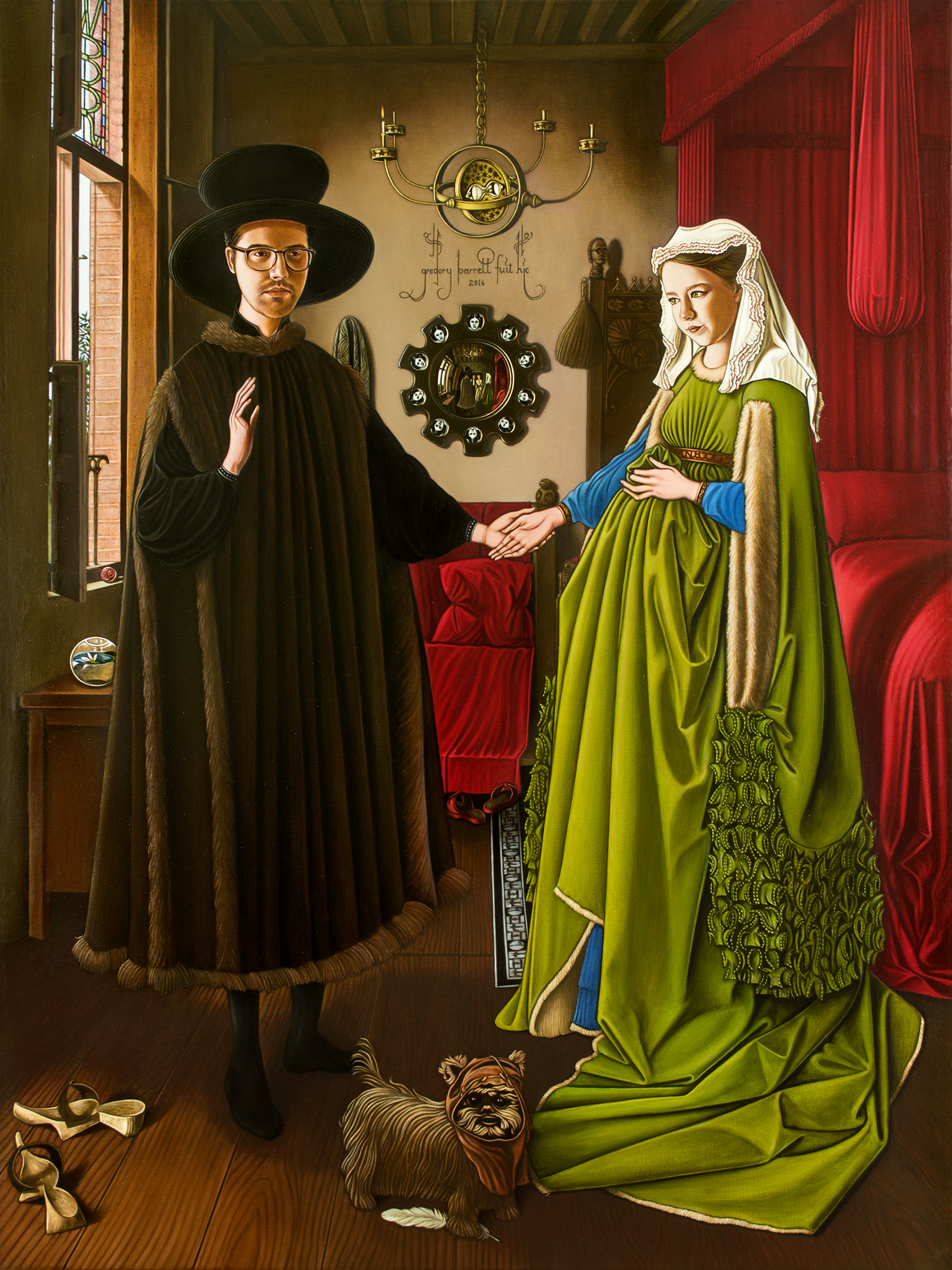The Wedding Portrait
Jan Van Eyck, in all likelihood, finished his oil on oak panel painting “The Arnolfini Portrait” or marriage or wedding in 1434. I’ve no idea how long it took him to paint this terribly wonderful and idiosyncratic double portrait but can only marvel at its execution and virtuosity. The work is a veritable tour de force of textural representation, geometric perspective, and complex iconography. It is one of my favorite paintings in all of western culture.
Every work I create is at once both a tribute and an interpretation. Every work I do takes on a life of its own once started. The lines, curves, shades, and colors of the evolving piece form a singular vocabulary of existence which speaks to me and dictates the form and direction of its development. Once began it is this two dimensional surface of shape and color that orders my manipulations and whispers in my ear whenever I look away. A work of this complexity is more a re-orchestration of myself rather than a subject of my direction. I created this painting in the method that Jan Van Eyck is believed to have done. After the composition was planned and drawn I painted a grisaille or black and white version on the canvas. Each section was painted twice in black and white and I then began using thin layers of glaze on top of each area to tint and colour the work. Some areas have as few as four layers of paint while some areas required five to seven. This provided the richness of colour and a depth to the forms and shapes I wanted for this work. I also developed a specific methodology to capture the details required, while still keeping the amount of time involved somewhat realistic for my needs and my time left upon this world. This painting took me five months or roughly one thousand hours to create but I came to realize that I easily could of worked upon it for years. I paused before starting my version when the amount of work and detail that would ultimately be required flashed before my eyes.
The subject of my painting is of the wedding of Wally and Amanda. Wally loves Star Wars, Amanda loves Harry Potter. I love both. My iconography in this work is the union of these two themes. The finials in the bedroom have been replaced with droids. These are the droids you’re looking for. Upon the bedpost is a representation of Chewbacca and the Millennium Falcon while depicted on the rug are images of tie fighters, x wings, and death stars. The mirror’s frame is edged with Princess Leia heads and the glasses’ reflection reveals Rey and Han Solo to be the witnesses or officiators of the event. I have given the small dog the head of the Ewok from "Return of the Jedi." The dog steps upon a white feather to represent the actor Warwick Davis, who played the Ewok Wicket and other roles in Star Wars, but who also played Professor Filius Flitwick in the Harry Potter films. The edge of Wally’s sleeve is adorned with seven stars which represent the seven Star Wars films released to this point but seven stars also represent the seven books of Harry Potter. Upon Amanda’s sleeve are mobius snakes that represent the intertwining relationship of Harry and Tom Ridley but also represent the infinity sign and the never ending nature of love; a theme of this painting and, besides tolerance, the overriding theme of the Harry Potter novels by J.K. Rowling. On Amanda’s belt are the first letters of the first words of all seven of the Potter books. I have replaced the chandelier with the Time Turner from the “Prisoner of Azkaban” and the little broom hanging from the bed is inscribed with the word Nimbus. In the window sill is a remembrall and on the small table is a lily floating in a bowl of water. The lily and bowl symbolizes the story told to Harry by Professor Horace Slughorn about his gift from Harry’s mother and, for me, also symbolizes the love that Severus Snape felt for Lily too. Jan Van Eyck signed his work “Johannes de eyck fruit hic 1434” which is latin for Jan Van Eyck was here, 1434. There has been much debate about this signature with some speculating that this signature forms some sort of legal record for the marriage. I signed mine here as well as for it is such a strong elemental piece of the composition. From the script arises a design of “He” towards the bride and “Ha” towards the groom. You see, as I read the books, I was always secretly hoping that Harry and Hermione would somehow unite. It is Harry’s invisibility cloak that hangs behind the groom and I replaced the Bullseye design of the stained glass window from the original painting with the stylized initials R.B.W. which stands for Ronald Bilius Weasley. I always viewed Ron as being on the outside looking in with regards to the relationship between Hermione and Harry. This painting actually represents the fictional marriage of Harry Potter and Hermione Granger. My painting is a record of the union between the two most powerful wizards of their day. Forgive me Ron, Joanne, and Rupert.
The single lit candle represents me and all of my desires.
Oil on Canvas 30"x40"



